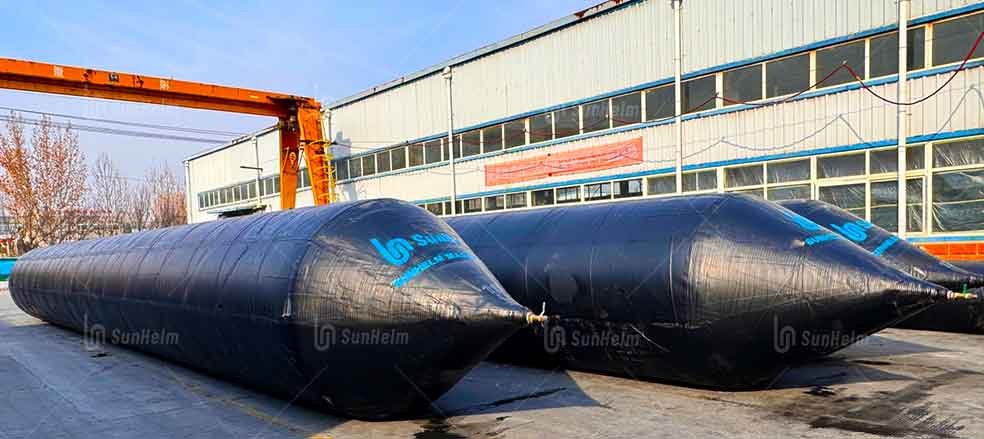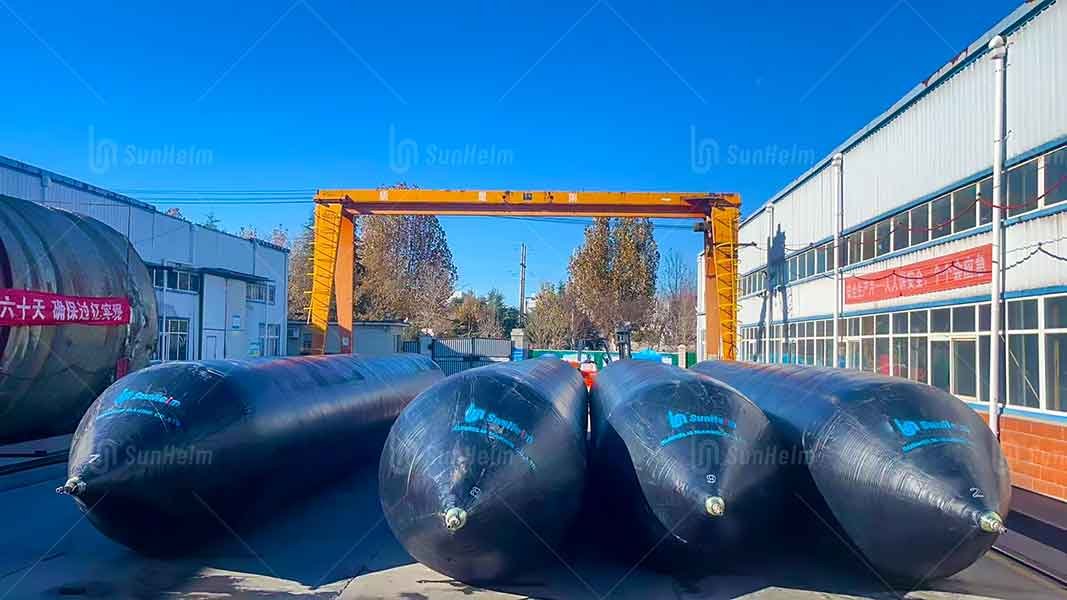1. Overview and Basic Structure
Ship launching airbags (also known as marine airbags, launching air tubes, or inflatable lifting bags) are flexible systems used for launching ships, lifting, rescue, and transportation. They mainly consist of:
- Reinforced body: Made with multiple layers of synthetic tire cord fabric using holistic wrapping. This gives the marine airbags high density and strong resistance to tearing.
- Inner and outer rubber layers: The inner layer ensures air tightness and pressure resistance. The outer layer protects against abrasion, aging, UV light, and seawater corrosion.
- Conical ends and valve system: These usually include swivel joints, safety valves, stainless steel ball valves, and pressure gauges. They ensure air sealing and make the operation easier.

2. Technical Features and Advantages
- Strong lifting and buoyancy power
The airbag’s buoyancy depends on its diameter, length, and air pressure. By using the ISO 14409 standard, users can calculate the exact number of marine airbags needed to balance and launch the ship safely. - High-pressure resistance
The multi-layer fabric design increases the airbag’s ability to handle high pressure and avoid bursting. The typical working pressure is 0.08–0.20 MPa, and the burst pressure is at least three times higher. - Flexible and adaptable
The flexible material fits the bottom of different ships. It works well on slopes, vertical surfaces, or for side launching. It supports small boats, medium vessels, and even large barges. - No need for fixed infrastructure
Traditional launching methods require steel frames or concrete ramps. Airbags need only simple tools. They are quick to set up, easy to remove, and flexible to use. - Cost-effective
Marine airbags are reusable for 5–8 years, and with proper care, up to 15+ years. They save over 30% of the total cost compared to traditional launching systems. - High safety
Air pressure is carefully controlled. The rubber is tough against wear and punctures, preventing damage to the ship. The simple operation also reduces the risk of accidents.
3. Wide Range of Applications
- Ship launching and lifting: Suitable for small to medium ships, and also for larger vessels like barges and floating cranes.
- Ship repair and conversion: Useful when dry docks are full or shore space is limited. Airbags can lift ships temporarily for maintenance.
- Marine rescue and salvage: Marine airbags can raise sunken ships for safe recovery.
- Heavy load transport: They can also help move large structures over land or during loading/unloading.
4. Safety Guidelines and Operation Steps
- Monitor pressure and avoid over-inflation
Always check the air pressure during inflation. Never go over the working pressure. Check if pressure gauges work well. - Test for air tightness
According to ISO 14409, the airbag should hold pressure for 1 hour without dropping more than 5%. - Prepare the ground before use
Clear any sharp objects on the ground. The surface should be flat and hard to avoid airbag punctures. - Inspect and maintain regularly
After each use, clean and dry the airbag. Apply talcum powder to prevent sticking. Store in a cool, dry, and ventilated place. - Choose the right number and layout
Based on the ship’s weight, length, and airbag size, use linear, staggered, or double-row layouts to keep pressure balanced.
5. Standards and Certifications
- Main international standards: ISO 14409 (pressure and size), ISO 17682 (launching method).
- Common certifications: ABS, BV, CCS, LR, DNV, and other major classification societies.
- Manufacturer warranties: Airbags are designed for 6–20 years of use. Most offer 18–24 months of warranty and regular inspection services.
6. Conclusion
Ship launching airbags are a proven, flexible launching method. They are lightweight, strong, safe, cost-saving, and easy to use. These advantages make them widely used in shipbuilding, repair, and rescue. With the right setup and regular maintenance, they can shorten project time, lower costs, and improve safety. As materials and technology improve, their applications will continue to grow.


